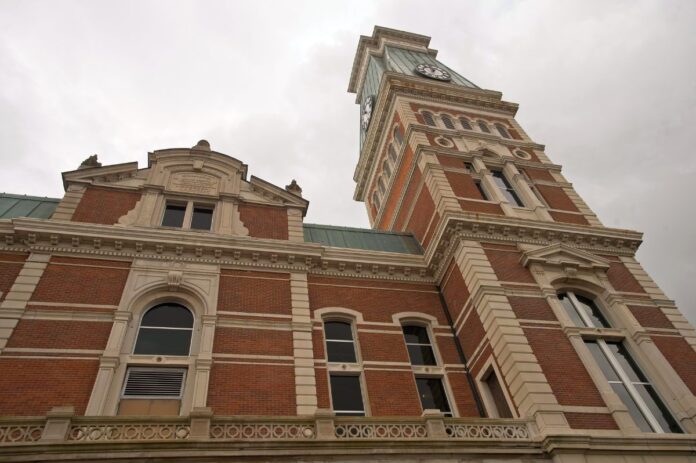
New political precincts, as well as redrawn districts for three Bartholomew County commissioners and four county council members, received preliminary approval Monday.
The commissioners plan to take a final vote on the proposal at 10 a.m. Dec. 20.
Two factors prompted most of the changes, Bartholomew County Clerk Shari Lentz said. One was the approval of new congressional districts signed into law Oct. 4 that splits Bartholomew County into two districts.
The 9th district, now represented by Joseph A. “Trey” Hollingsworth, R-Jeffersonville, will now include all of Jackson, Ohio and Wayne townships, as well as the southern part of Sandcreek Township. A new precinct has been created out of the northern part of Sandcreek Township, including Elizabethtown, that will be known as Precinct 5350, Lentz said.
That new precinct, as well as the remainder of Bartholomew County and the entire city of Columbus, will all be part of the 2nd Congressional District represented by Rep. Greg Pence, R-Columbus.
While these new congressional districts played a small role in redrawing county boundaries, most changes were necessitated by several annexations that have taken place over the past 10 years, Lentz said.
These annexations created what Lentz called “splits” in precincts. One type of split is when annexation leaves an established precinct in two council districts, the clerk said. That creates problems in assuring that every person receives the correct ballot at the voting centers, she said.
Commissioners’ Chairman Larry Kleinhenz says an annexation could also trigger a split because one part of a precinct could vote in the city’s elections, while another part will be excluded.
In total, the county commissioners addressed a total of 15 splits when new districts and precincts were considered, Lentz said. Nine were newly-created splits caused by annexation, while the remaining six have been in existence for some time, she said.
Nearly 800 voters will find themselves voting in a different county council district if the proposed changes are given final approval. In redrawing districts, the commissioners attempted to allocate about the same number of voters in each of the county council districts, commissioner Carl Lienhoop said.
In a breakdown supplied by Lentz, here’s the changes in the county council districts.
Five residents in the vicinity of Rocky Ford and Talley roads who have voted in Council District 2 (represented by Greg Duke) will vote in Council District 1 (represented by Scott Bonnell).
In another proposed change, 169 voters residing south of Rocky Ford Road, between Marr and Taylor roads, will switch from voting in Duke’s district to casting ballots in Bonnell’s district.
The largest proposed change involved 363 voters in areas of southwest Columbus – as well as just outside the city limits – who may soon be voting in Council District 3, now represented by Mark Gorbett. Currently, these residents are voting in Council District 4, represented by Jorge Morales.
The same can be said in regard to 111 voters residing on Columbus’ historic southwest side, a section of Tipton Lakes and a number of new subdivisions in southwest Bartholomew County.
Under the proposal, 48 voters from a variety of districts will be shifted from Morales’ territory to Gorbett’s precinct. They reside in historic Columbus, along Indianapolis Road, just south of Garden City and the far west side of Tipton Lakes.
But Morales will pick up 97 voters from Gorbett’s district on the east side of Tipton Lakes as well as subdivisions south and east of the Bartholomew County Fairgrounds.
As the new county council boundaries were created, efforts were made to keep districts within township lines, Kleinhenz said. That was not a consideration for the three at-large council members – Evelyn Pence, Matt Miller and Bill Lentz – who represent the entire county.
After the changes receive final consideration on the local level on Dec. 20, all proposed changes will still be subject to final approval from the state office of Census Data and the Indiana Election Division, Shari Lentz said. The proposed new boundaries have to be submitted to the state no later than Dec. 31, she said.
Kleinhenz asked Lentz for assurances there was no gerrymandering going on in establishing new precincts and districts for elected county officials. Gerrymandering is a term referring to the manipulation of political boundaries of an electoral constituency, in order to favor one party over another.
Gerrymandering in the county commissioners’ districts is not a concern because every eligible resident can vote in any of the three commissioners races – no matter where they live in Bartholomew County, commissioner Carl Lienhoop said. It has long been the practice of the local commissioners to vote in the best interest of all county residents, rather than just those in their district, commissioner Tony London said.
But each commissioner must live within their district – a requirement designed to ensure that different areas of the county are represented in the county’s executive board, Lienhoop said.




